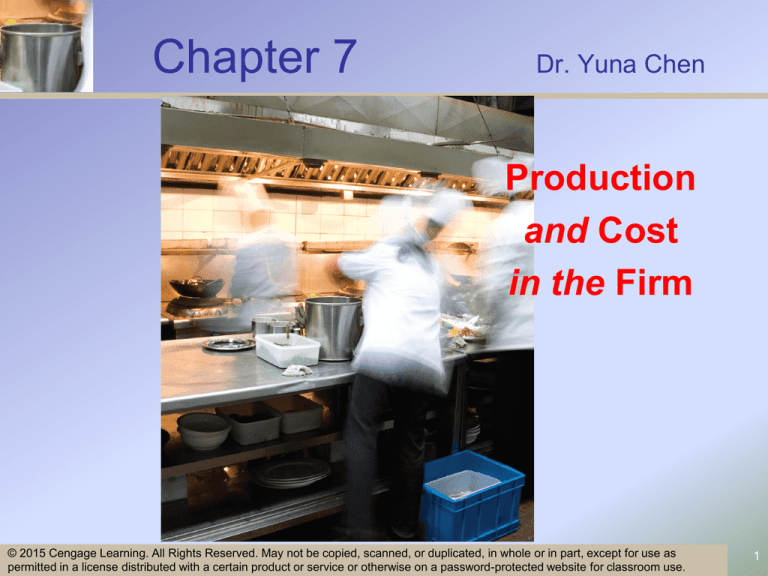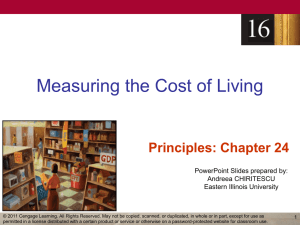
Chapter 7
Dr. Yuna Chen
Production
and Cost
in the Firm
© 2015 Cengage Learning. All Rights Reserved. May not be copied, scanned, or duplicated, in whole or in part, except for use as
permitted in a license distributed with a certain product or service or otherwise on a password-protected website for classroom use.
1
Cost and Profit
• Producers’ goal: maximize profit
• Explicit costs:
– Actual cash payments for resources (wage, rent…)
on the accounting statement
• Implicit costs:
– opportunity cost of using the resources
– Not a cash payment
– Not on the accounting statement
2
© 2015 Cengage Learning. All Rights Reserved. May not be copied, scanned, or duplicated, in whole or in part, except for use as
permitted in a license distributed with a certain product or service or otherwise on a password-protected website for classroom use.
2
Cost and Profit
Example1. Eric took $200,000 from his saving
account which pays 5% interest, to open his own
business. In the 1st year, he pays $50,000 to the
employees, and $150,000 to inventories. He gave
up his $32,000 job in order to manage his business.
Explicit costs = $50,000 + $150,000 = $200,000
Implicit costs = ($200,000)(5%)+ $32,000 =$42,000
Total costs = $200,000 + $42,000 = $242,000
3
© 2015 Cengage Learning. All Rights Reserved. May not be copied, scanned, or duplicated, in whole or in part, except for use as
permitted in a license distributed with a certain product or service or otherwise on a password-protected website for classroom use.
3
Alternative Measures of Profit
• Accounting profit
= Total revenue - explicit costs
• Economic profit
= Total revenue minus total costs (implicit
and explicit)
• Normal profit
– Occurred when accounting profit earned
can cover all implicit cost
– occurred when economic profit = 0
© 2015 Cengage Learning. All Rights Reserved. May not be copied, scanned, or duplicated, in whole or in part, except for use as
permitted in a license distributed with a certain product or service or otherwise on a password-protected website for classroom use.
4
Alternative Measures of Profit
Example 2. Continue on Example 1. At the end of the 1st
year, Eric’s yearly total revenue is $220,000.
Accounting profit = $220,000 - $200,000 =$20,000
Economic profit = $220,000 – $242,000 = -$22,000
Eric earns normal profit if his accounting profit is $42,000,
which can cover his implicit cost.
5
Production in the Short Run
• Variable resources
– Can be varied in the short run to increase
or decrease production
• Fixed resources
– Cannot be varied in the short run
• Short run
– At least one resource is fixed
• Long run
– All resources can vary
© 2015 Cengage Learning. All Rights Reserved. May not be copied, scanned, or duplicated, in whole or in part, except for use as
permitted in a license distributed with a certain product or service or otherwise on a password-protected website for classroom use.
6
Diminishing Marginal Returns
• Total product
– A firm’s total output
• Marginal product
– Change in total product from an
additional unit of resource
Classroom Experiment: Making cookies
© 2015 Cengage Learning. All Rights Reserved. May not be copied, scanned, or duplicated, in whole or in part, except for use as
permitted in a license distributed with a certain product or service or otherwise on a password-protected website for classroom use.
7
Diminishing Marginal Returns
• Law of diminishing marginal returns
– As more of a variable resource is added
to a given amount of another resource,
marginal product eventually declines
• Could become negative
© 2015 Cengage Learning. All Rights Reserved. May not be copied, scanned, or duplicated, in whole or in part, except for use as
permitted in a license distributed with a certain product or service or otherwise on a password-protected website for classroom use.
8
Costs in the Short Run
• Fixed cost, FC
– Any production cost that is independent
of the firm’s amount of output
– Costs that is paid out even when no
output is made
• Variable cost, VC
– Any production cost that changes as the
amount of output changes
• Total cost, TC = FC + VC
© 2015 Cengage Learning. All Rights Reserved. May not be copied, scanned, or duplicated, in whole or in part, except for use as
permitted in a license distributed with a certain product or service or otherwise on a password-protected website for classroom use.
9
Costs in the Short Run
• Marginal cost, MC = ∆TC/∆q
– Change in total cost resulting from a oneunit change in output
© 2015 Cengage Learning. All Rights Reserved. May not be copied, scanned, or duplicated, in whole or in part, except for use as
permitted in a license distributed with a certain product or service or otherwise on a password-protected website for classroom use.
10
Costs in the Short Run
Example 3. You are thinking about setting up a lemonade
stand. The stand itself costs $200. The ingredients for each
cup of lemonade cost $0.50.
If you make 100 cups, what is FC, VC, TC and MC?
FC = $200 (cost for the stand is fixed)
VC = ($0.50)(100) = $50 (cost for ingredients varies)
TC = $200 + $50 = $250
As for MC,
Q = 99, TC = $249.50
Q = 100, TC = $250
MC = $250 - $249.50 = $0.50
© 2015 Cengage Learning. All Rights Reserved. May not be copied, scanned, or duplicated, in whole or in part, except for use as
permitted in a license distributed with a certain product or service or otherwise on a password-protected website for classroom use.
11
Cost Curves
Let’s draw these 3 cost curves:
FC, VC, and TC
© 2015 Cengage Learning. All Rights Reserved. May not be copied, scanned, or duplicated, in whole or in part, except for use as
permitted in a license distributed with a certain product or service or otherwise on a password-protected website for classroom use.
12
Costs in the Short Run
• Fixed cost curve
– Straight horizontal line
• Variable cost curve
– Starts at the origin and up
• Total cost curve
– Fixed cost curve + variable cost curve
• Marginal cost
- Slope of total cost curve
© 2015 Cengage Learning. All Rights Reserved. May not be copied, scanned, or duplicated, in whole or in part, except for use as
permitted in a license distributed with a certain product or service or otherwise on a password-protected website for classroom use.
13
Average Cost in the Short Run
• Average variable cost, AVC = VC/q
– Variable cost divided by output
• Average fixed cost, AFC = FC/q
– Fixed cost divided by quantity
• Average total cost, ATC = TC/q
– Total cost divided by output
– ATC = AFC + AVC
© 2015 Cengage Learning. All Rights Reserved. May not be copied, scanned, or duplicated, in whole or in part, except for use as
permitted in a license distributed with a certain product or service or otherwise on a password-protected website for classroom use.
14
Example 4
See handout
© 2015 Cengage Learning. All Rights Reserved. May not be copied, scanned, or duplicated, in whole or in part, except for use as
permitted in a license distributed with a certain product or service or otherwise on a password-protected website for classroom use.
15
Average Cost in the Short Run
• AFC is always declining as output
increases, but never touch the x axis
• These curves are U-shaped, first
declining then rising, AVC, ATC, MC
• ATC is always above AVC. The vertical
gap between ATC and AVC is AFC.
• MC goes through the minimum point of
AVC and ATC.
© 2015 Cengage Learning. All Rights Reserved. May not be copied, scanned, or duplicated, in whole or in part, except for use as
permitted in a license distributed with a certain product or service or otherwise on a password-protected website for classroom use.
16
Costs in the Long Run
• Long run
– Planning horizon
– All resources can be varied
• Firms plan for the long run
• Firms produce in the short run
© 2015 Cengage Learning. All Rights Reserved. May not be copied, scanned, or duplicated, in whole or in part, except for use as
permitted in a license distributed with a certain product or service or otherwise on a password-protected website for classroom use.
17
Example 5.
Example 5
Weekly Cost
Jone’s Farm
Labor
(15 hours)(Implicit $12/hr) =
Chicken Little Egg Farm, Inc
Wage = $5,128
Feed
$25
$4,115
Transportation
$15
$2,431
Land and Capital
$17
$19,230
Total Cost
Total output
2400 eggs
1,600,000 eggs
AT C
© 2015 Cengage Learning. All Rights Reserved. May not be copied, scanned, or duplicated, in whole or in part, except for use as
permitted in a license distributed with a certain product or service or otherwise on a password-protected website for classroom use.
18
Costs in the Long Run
• Economies of scale
– a firm’s average cost declines
as the scale of operation increases
• Diseconomies of scale
a firm’s average cost increases as the
scale of operation increases
• Constant returns to scale
– a firm’s average cost remains constant
as the scale of operation increases
© 2015 Cengage Learning. All Rights Reserved. May not be copied, scanned, or duplicated, in whole or in part, except for use as
permitted in a license distributed with a certain product or service or otherwise on a password-protected website for classroom use.
19
Costs in the Long Run
• Long-run average cost curve
– Indicates the lowest average cost of
production in the short run
– Planning curve
– U-shaped
© 2015 Cengage Learning. All Rights Reserved. May not be copied, scanned, or duplicated, in whole or in part, except for use as
permitted in a license distributed with a certain product or service or otherwise on a password-protected website for classroom use.
20






